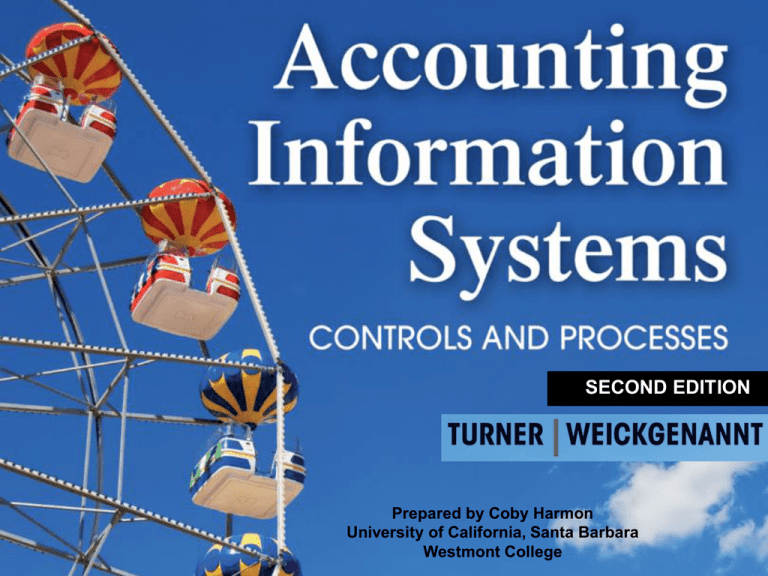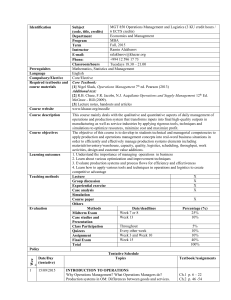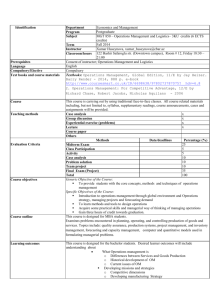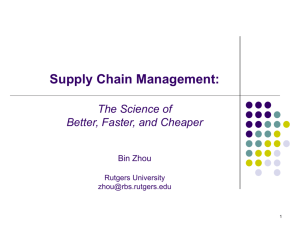
SECOND EDITION
Chapter
11-1
Prepared
by CobybyHarmon
Prepared
Coby Harmon
University
of California,
Santa Barbara
University
of California,
Santa Barbara
Westmont
Westmont
CollegeCollege
Conversion Processes
and Controls
Chapter
11-2
Study Objectives
1. Basic features of conversion processes
2. The components of the logistics function
3. Cost accounting reports generated by conversion
processes
4. Risks and controls in conversion processes
5. IT systems of conversion processes
6. Ethical issues related to conversion processes
7. Corporate governance in conversion processes
Chapter
11-3
Real World
Nissan Motor Company’s automobile plant near Jackson, Mississippi,
has cutting-edge technology and robotic assemblers.
“Assembly lines are powered by enormous robots; at one stop in the
line, a bay of over 25 robots each make 12 welds per second.
Suppliers are tied into the line by computers; parts actually arrive in
the order they’ll be used.”
The complex technology allows Nissan to handle four different
models in random order and to finish a vehicle in 13 hours. The plant
can produce 400,000 vehicles in a five-day period with two shifts
operating.
Chapter
11-4
Basic Features of Conversion Processes
Conversion processes involve activities related to the
transformation of resources into goods or services.
Resources include:
Chapter
11-5
Materials
Labor
Overhead
Various other expenses necessary to run the operating
facility
SO 1 Basic features of conversion processes
Basic Features of Conversion Processes
Major activities within this process include
Operational planning,
Optimizing use of employees, property, and inventories,
Controlling production flows,
Ensuring product quality, and
Preparing related cost accounting and financial accounting
records.
Chapter
11-6
SO 1 Basic features of conversion processes
Exhibit 11-1
Conversion Processes within
the Overall System
Basic Features of
Conversion
Processes
Chapter
11-7
SO 1 Basic features of conversion processes
Basic Features of Conversion Processes
Exhibit 11-2
Overview of the
Conversion Processes
Chapter
11-8
SO 1 Basic features of conversion processes
Basic Features of Conversion Processes
Concept Check
Manufacturing has changed in recent years as a result of
each of the following factors except:
a. globalization
b. technological advances
c. increased competition
d. lack of economic prosperity
Chapter
11-9
SO 1 Basic features of conversion processes
Components of the Logistics Function
Logistics is the logical, systematic flow of resources
throughout the organization.
Three primary components:
Chapter
11-10
planning,
resource management, and
operations.
SO 2 The components of the logistics function
Components of the Logistics Function
bill of materials
operations list
Production orders
Exhibit 11-3
Components of the
Logistics Function
Chapter
11-11
Production schedule
SO 2 The components of the logistics function
Components of the Logistics Function
Terminology
Chapter
11-12
Economic Order Quantities (EOQ)
Raw materials
Work-in-process
Finished goods
Inventory status report
Exhibit 11-3
Components of the
Logistics Function
SO 2 The components of the logistics function
Components of the Logistics Function
Operations may be performed by :
Continuous processing of homogeneous products
Batch processing
Custom, made-to-order processing
Chapter
11-13
Exhibit 11-3
Components of the
Logistics Function
SO 2 The components of the logistics function
Components of the Logistics Function
Exhibit 11-5
Production Process Map
See next slide for larger image.
Chapter
11-14
SO 2 The components of the logistics function
Components of the Logistics Function
Exhibit 11-5
Production Process Map
Chapter
11-15
SO 2 The components of the logistics function
Components of the Logistics Function
Exhibit 11-5
Production Process Map
Chapter
11-16
SO 2 The components of the logistics function
Components of the Logistics Function
Concept Check
The term conversion processes is often used synonymously
with
a. operations.
b. production.
c. manufacturing.
d. all of the above.
Chapter
11-17
SO 2 The components of the logistics function
Components of the Logistics Function
Concept Check
Which of the following activities is not part of the planning
component of the logistics function?
a. Research and development
b. Capital budgeting
c. Human resource management
d. Scheduling
Chapter
11-18
SO 2 The components of the logistics function
Components of the Logistics Function
Concept Check
Which of the following terms relates to the control of materials
being held for future production?
a. Routing
b. Work-in-process
c. Stores
d. Warehousing
Chapter
11-19
SO 2 The components of the logistics function
Components of the Logistics Function
Concept Check
When additional procedures are necessary to bring a
defective product up to its required specifications, this is
referred to as
a. rework.
b. scrap.
c. work-in-process.
d. variance reporting.
Chapter
11-20
SO 2 The components of the logistics function
Components of the Logistics Function
Concept Check
A firm expects to sell 1000 units of its best-selling product in
the coming year. Ordering costs for this product are $100 per
order, and carrying costs are $2 per unit. Compute the
optimum order size, using the EOQ model.
a. 10 units
b. 224 units
c. 317 units
d. 448 units
Chapter
11-21
SO 2 The components of the logistics function
Cost Accounting Reports Generated by
Conversion Processes
Standard costs are expected costs based on projections of
a product’s required resources.
Perpetual inventory systems involve
Chapter
11-22
recording purchases as raw materials inventory,
recording all components of work-in-process for inventories
in various stages of production, and
recording total cost of sales for products completed and
sold.
SO 3 Cost accounting reports generated by conversion processes
Cost Accounting Reports Generated by
Conversion Processes
Periodic inventory systems involve
updating the inventory and
cost of sales accounts
only at the end of the period.
Variances represent the differences between actual costs
and the standard costs applied.
Chapter
11-23
SO 3 Cost accounting reports generated by conversion processes
Risks and Controls in Conversion
Processes
Common procedures within the conversion process:
Chapter
11-24
Authorization of transactions
►
Initiation of production orders
►
Issuance of materials into production
►
Transfer finished goods to warehouse or shipping
areas
Segregation of duties
Adequate records and documents
SO 4 Risks and controls in conversion processes
Risks and Controls in Conversion
Processes
Common procedures within the conversion process:
Security of assets and documents
Independent checks and reconciliation
Chapter
11-25
►
Physical inventory count
►
Physical inventory reconciliation
Cost-benefit considerations
SO 4 Risks and controls in conversion processes
Risks and Controls in Conversion
Processes
Concept Check
Which of the following internal controls is typically associated with the
maintenance of accurate inventory records?
a.
Performing regular comparisons of perpetual records with recent
costs of inventory items
Chapter
11-26
b.
Using a just-in-time system to keep inventory levels at a minimum
c.
Performing a match of the purchase request, receiving report, and
purchase order before payment is approved
d.
Using physical inventory counts as a basis for adjusting the
perpetual records
SO 4 Risks and controls in conversion processes
Risks and Controls in Conversion
Processes
Concept Check
The goal of a physical inventory reconciliation is to
a. determine the quantity of inventory sold.
b. compare the physical count with the perpetual records.
c. compare the physical count with the periodic records.
d. determine the quantity of inventory in process.
Chapter
11-27
SO 4 Risks and controls in conversion processes
IT Systems of Conversion Processes
Computerized systems may provide the following benefits:
Chapter
11-28
Automatic computation of materials requirements
Systematic scheduling that allows for greater flexibility and
increased efficiencies
Timely transfer of inventories due to the automatic
notification features
Validation of data entries
Automatic updating of inventory status reports
Automatic preparation of financial accounting entries and
cost accounting reports
SO 5 IT systems of conversion processes
IT Systems of Conversion Processes
Additional trends that enhance the conversion process:
Chapter
11-29
Computer-aided design (CAD)
Computer-aided manufacturing (CAM)
Materials resource planning (MRP)
Manufacturing resource planning (MRP-II)
Enterprise-wide resource planning (ERP)
Computer-integrated manufacturing systems (CIMs)
Just-in-time (JIT) production systems
Radio-frequency identification (RFID)
SO 5 IT systems of conversion processes
Real World
Jean Larrivée Guitars designs and manufactures
steel string guitars and mandolins known to
produce a distinctively clear sound because of their great structural integrity
due to the company’s symmetrical bracing system. There are dozens of
models manufactured; however, before any of them can be made into an
actual product, its design is worked out in CAD drawings. The digitized data
from the CAD process is then brought to the factory to be replicated. Larrivée
uses CAD to design many pieces of its instruments, including the neck,
bridge, fingerboard, kurfing, rosette, and inlays. For the neck alone,
approximately 450 hours of programming time were required to precisely
design the piece that would appease both professional guitarists and
beginners. Even this considerable investment of time is merely a fraction of
what would have been required to achieve such precision without
computerization. In addition, through CAD, the cost of drawing blueprints is
greatly reduced. Once the lines of an instrument are drawn in CAD, Larrivée
uses a CAM system for cutting the parts. Cutting requires extreme precision,
yet Larrivée’s use of CAM can actually improve quality and increase
efficiency by machining six fingerboards at a time. This makes it possible to
free up human resources for more challenging (but less precise) tasks.
Chapter
11-30
SO 5
Wild West Motor Company, a custom motorcycle
manufacturer, uses Alias Studio software
provided by Autodesk, Inc., for its CAD and CAM processes. This
software has played an instrumental role in helping Wild West double
production in recent years and spark a corresponding increase in sales.
Real World
Wild West uses CAD software to prepare digital
models of motorcycle tanks and seats. These models are imported into
the CAM system to create solid models of the actual parts or as a
starting point for a mold or die. The integration of the two systems allows
for easy back-and-forth transfers for making refinements. Paul Seiter,
Wild West’s founder, estimates that the company saves $75,000, plus
weeks—or months—of engineering and production time, for each project
now being designed and tooled in-house (compared with the cost of
outsourcing those projects). Furthermore, Seiter has challenged the
company’s engineers to use the software to create innovative styles to
incorporate into the company’s products in order to build a competitive
advantage.
Chapter
11-31
SO 5
IT Systems of Conversion Processes
Match IT systems on left with their definitions on the right:
CAD
a. A network including production equipment, computer
terminals, and accounting systems
CAM
b. Electronic workstation including advanced graphics and 3-D
modeling of production processes
MRP
c. Automated scheduling of manufacturing resources, including
scheduling, capacity, and forecasting functions
MRP-II
ERP
d. The minimization of inventory levels by the control of production so
that products are produced on a tight schedule in time for their sale
CIMs
e. A single software system that includes all manufacturing and related
accounting applications
JIT
RFID
Chapter
11-32
f. Automated scheduling of production orders and materials movement
g. Production automation, including use of computers and robotics
h. The use of tiny tags affixed to inventory items to automatically
monitor movement and account for the various stages of processing.
SO 5
IT Systems of Conversion Processes
Match IT systems on left with their definitions on the right:
CAD
a. A network including production equipment, computer
terminals, and accounting systems
CAM
b. Electronic workstation including advanced graphics and 3-D
modeling of production processes
MRP
c. Automated scheduling of manufacturing resources, including
scheduling, capacity, and forecasting functions
MRP-II
ERP
d. The minimization of inventory levels by the control of production so
that products are produced on a tight schedule in time for their sale
CIMs
e. A single software system that includes all manufacturing and related
accounting applications
JIT
RFID
Chapter
11-33
f. Automated scheduling of production orders and materials movement
g. Production automation, including use of computers and robotics
h. The use of tiny tags affixed to inventory items to automatically
monitor movement and account for the various stages of processing.
SO 5
IT Systems of Conversion Processes
Match IT systems on left with their definitions on the right:
CAD
a. A network including production equipment, computer
terminals, and accounting systems
CAM
b. Electronic workstation including advanced graphics and 3-D
modeling of production processes
MRP
MRP-II
c. Automated scheduling of manufacturing resources, including
scheduling, capacity, and forecasting functions
ERP
d. The minimization of inventory levels by the control of production so
that products are produced on a tight schedule in time for their sale
CIMs
e. A single software system that includes all manufacturing and related
accounting applications
JIT
RFID
Chapter
11-34
f. Automated scheduling of production orders and materials movement
g. Production automation, including use of computers and robotics
h. The use of tiny tags affixed to inventory items to automatically
monitor movement and account for the various stages of processing.
SO 5
IT Systems of Conversion Processes
Match IT systems on left with their definitions on the right:
CAD
a. A network including production equipment, computer
terminals, and accounting systems
CAM
b. Electronic workstation including advanced graphics and 3-D
modeling of production processes
MRP
MRP-II
c. Automated scheduling of manufacturing resources, including
scheduling, capacity, and forecasting functions
ERP
d. The minimization of inventory levels by the control of production so
that products are produced on a tight schedule in time for their sale
CIMs
e. A single software system that includes all manufacturing and related
accounting applications
JIT
RFID
Chapter
11-35
f. Automated scheduling of production orders and materials movement
g. Production automation, including use of computers and robotics
h. The use of tiny tags affixed to inventory items to automatically
monitor movement and account for the various stages of processing.
SO 5
IT Systems of Conversion Processes
Match IT systems on left with their definitions on the right:
CAD
a. A network including production equipment, computer
terminals, and accounting systems
CAM
b. Electronic workstation including advanced graphics and 3-D
modeling of production processes
MRP
MRP-II
c. Automated scheduling of manufacturing resources, including
scheduling, capacity, and forecasting functions
ERP
d. The minimization of inventory levels by the control of production so
that products are produced on a tight schedule in time for their sale
CIMs
e. A single software system that includes all manufacturing and related
accounting applications
JIT
RFID
Chapter
11-36
f. Automated scheduling of production orders and materials movement
g. Production automation, including use of computers and robotics
h. The use of tiny tags affixed to inventory items to automatically
monitor movement and account for the various stages of processing.
SO 5
IT Systems of Conversion Processes
Match IT systems on left with their definitions on the right:
CAD
a. A network including production equipment, computer
terminals, and accounting systems
CAM
b. Electronic workstation including advanced graphics and 3-D
modeling of production processes
MRP
MRP-II
c. Automated scheduling of manufacturing resources, including
scheduling, capacity, and forecasting functions
ERP
d. The minimization of inventory levels by the control of production so
that products are produced on a tight schedule in time for their sale
CIMs
e. A single software system that includes all manufacturing and related
accounting applications
JIT
RFID
Chapter
11-37
f. Automated scheduling of production orders and materials movement
g. Production automation, including use of computers and robotics
h. The use of tiny tags affixed to inventory items to automatically
monitor movement and account for the various stages of processing.
SO 5
IT Systems of Conversion Processes
Match IT systems on left with their definitions on the right:
CAD
a. A network including production equipment, computer
terminals, and accounting systems
CAM
b. Electronic workstation including advanced graphics and 3-D
modeling of production processes
MRP
MRP-II
c. Automated scheduling of manufacturing resources, including
scheduling, capacity, and forecasting functions
ERP
d. The minimization of inventory levels by the control of production so
that products are produced on a tight schedule in time for their sale
CIMs
e. A single software system that includes all manufacturing and related
accounting applications
JIT
RFID
Chapter
11-38
f. Automated scheduling of production orders and materials movement
g. Production automation, including use of computers and robotics
h. The use of tiny tags affixed to inventory items to automatically
monitor movement and account for the various stages of processing.
SO 5
IT Systems of Conversion Processes
Match IT systems on left with their definitions on the right:
CAD
a. A network including production equipment, computer
terminals, and accounting systems
CAM
b. Electronic workstation including advanced graphics and 3-D
modeling of production processes
MRP
MRP-II
c. Automated scheduling of manufacturing resources, including
scheduling, capacity, and forecasting functions
ERP
d. The minimization of inventory levels by the control of production so
that products are produced on a tight schedule in time for their sale
CIMs
e. A single software system that includes all manufacturing and related
accounting applications
JIT
f. Automated scheduling of production orders and materials movement
g. Production automation, including use of computers and robotics
RFID
Chapter
11-39
h. The use of tiny tags affixed to inventory items to automatically
monitor movement and account for the various stages of processing.
SO 5
IT Systems of Conversion Processes
Concept Check
Which of the following is not considered a benefit of using
computerized conversion systems?
a. Automatic computation of materials requirements
b. Increased sales and cost of sales
c. Increased efficiency and flexibility
d. Early error detection and increased accuracy
Chapter
11-40
SO 5 IT systems of conversion processes
IT Systems of Conversion Processes
Concept Check
Which of the following represents a method of managing
inventory designed to minimize a company’s investment in
inventories by scheduling materials to arrive at the time they
are needed for production?
a. The economic order quantity (EOQ)
b. Material resource planning (MRP)
c. First-in, first-out (FIFO)
d. Just-in-time (JIT)
Chapter
11-41
SO 5 IT systems of conversion processes
IT Systems of Conversion Processes
Concept Check
For which of the following computerized conversion systems
is Wal-Mart well known?
a. CAD/CAM
b. MRP-II
c. CIMs
d. JIT
Chapter
11-42
SO 5 IT systems of conversion processes
In the mid-1960s, most retailers were not yet
focused on computerized operations. Although there
were only 20 Wal-Mart stores at that time, Sam Walton was already focused on
the need to computerize merchandise controls in order to outpace competitors
like Kmart, Target, and Woolworth. Sam Walton recruited the top student from
IBM’s New York training school to come to Bentonville, Arkansas, to lead WalMart’s computerization efforts.
Real World
Sam Walton’s foresight brought unprecedented
success. Today, Wal-Mart is known for its sophisticated logistics and just-in-time
inventory system. Its computer database is one of the largest in existence for a
retail company.
In addition, Wal-Mart uses RFID technology to track
and record inventories, and requires that its top suppliers also use RFID. When
its suppliers use RFID, it allows Wal-Mart to track purchased items as they are
received at distribution warehouses, loaded on trucks, and moved to retail stores.
Within the retail stores, it allows workers to easily determine what is on the
shelves and what might be missing. For example, they could quickly see which
size of Wrangler jeans is out of stock on the shelves. This allows them to quickly
Chapter
restock, which improves sales and leads to more satisfied customers.
11-43
SO 5 IT systems of conversion processes
Ethical Issues Related to Conversion
Processes
Earnings management is the act of misstating financial
information in order to improve financial statement results.
Absorption costing involves the inclusion of both variable
and fixed costs in the determination of unit costs for ending
inventories and cost of goods sold.
Chapter
11-44
SO 6 Ethical issues related to conversion processes
In the early 1990s, an inventory fraud scheme was
discovered at F&C International, Inc. is a
manufacturer of flavors and fragrances, with operations in New York and
Cincinnati. Its founder and majority owner, Jon Fries, engaged in a series of
frauds, all of which involved the conversion process. Fries mislabeled
Real World
inventory items in order to overstate their value, recorded fictitious production
and shipping activities, and falsified sales figures in an attempt to meet
projections. He even appointed a task force of employees who were ordered
to carry out these plans. The task force was also instructed to alter reports
and destroy certain supporting documentation. His motive for committing
these crimes was threefold: He desired to increase profits in order to improve
the reputation of the company, improve his relationship with the company’s
debtors in order to expand his borrowing potential, and increase his own
compensation. Fries was convicted of fraud and served a prison sentence.
The frauds he orchestrated led to the company’s ultimate downfall.
Chapter
11-45
SO 6 Ethical issues related to conversion processes
Corporate Governance in Conversion
Processes
The internal controls and ethical tone and procedures within
the conversion process are also part of the corporate
governance structure.
Establishing and maintaining reliable inventory
management processes, internal controls, and ethical
practices help ensure proper financial stewardship.
Chapter
11-46
SO 7 Corporate governance in conversion processes
Copyright
Copyright © 2013 John Wiley & Sons, Inc. All rights reserved.
Reproduction or translation of this work beyond that permitted in
Section 117 of the 1976 United States Copyright Act without the
express written permission of the copyright owner is unlawful.
Request for further information should be addressed to the
Permissions Department, John Wiley & Sons, Inc. The purchaser
may make back-up copies for his/her own use only and not for
distribution or resale. The Publisher assumes no responsibility for
errors, omissions, or damages, caused by the use of these
programs or from the use of the information contained herein.
Chapter
11-47








